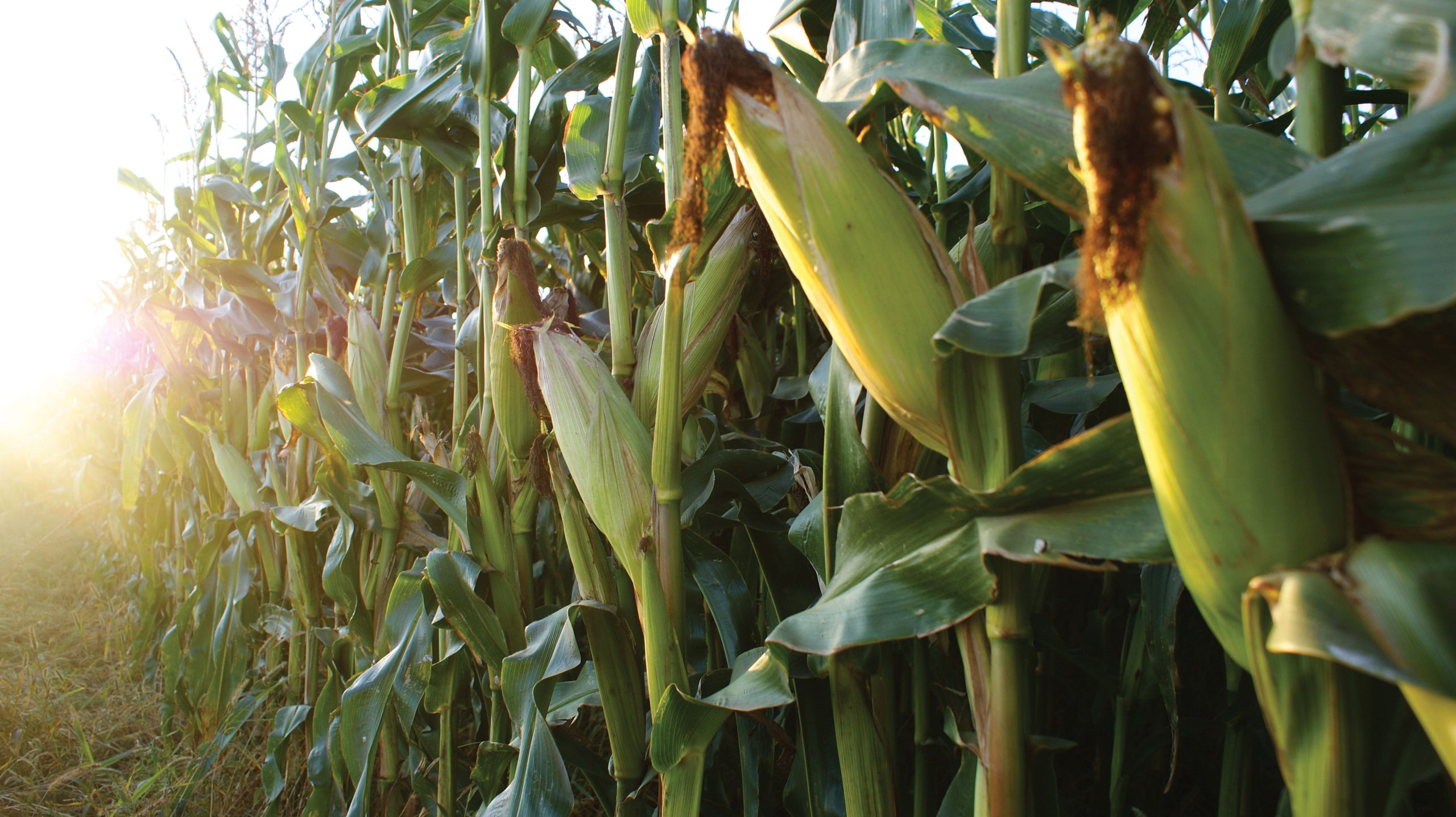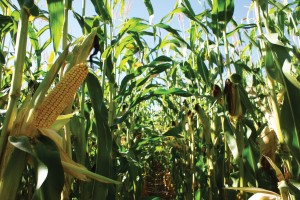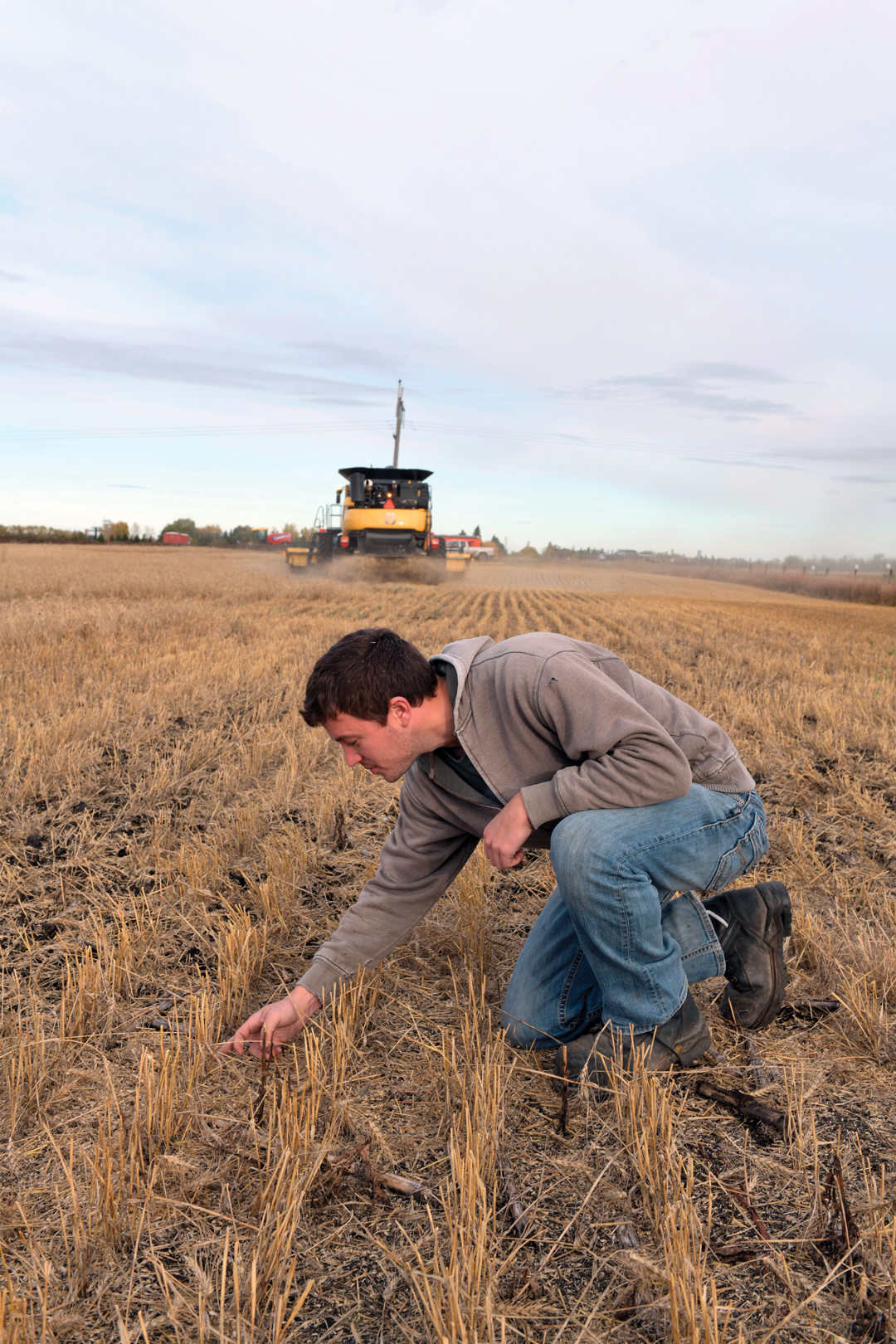KING CORN
CORN ACRES ARE ON THE RISE—BUT WHAT ABOUT SOYBEANS?
STORY AND PHOTOGRAPHY BY JOHN DIETZ
Down in feedlot alley, corn is solid.
It produces well and it feeds a lot of cattle. Inevitably, the question comes up, “Could there be another opportunity—the opportunity to grow far more acres using new grain corn varieties developed for the western Prairies?”
“We are definitely dabbling in the bottom of the corn maturity heat units just to make grain. If we get a real good year, like last year, that will help out,” said Adrian Moens, seed supplier and owner of AJM Seeds in Coalhurst.
Moens has been selling corn for almost 18 years. Today, he’s the Pioneer Hi-Bred sales representative for an area along Highway 3 between Picture Butte and Coaldale. His roots in the industry stretch north to Edmonton.
In Alberta’s fodder business, barley is still No. 1, but corn has become a challenger as a silage source. Some of Moens’ customers “grow 100 per cent corn because they get more tonnes per acre,” he explained. “Today, there are more and more feedlots going to corn. It’s been proven in this area.”
According to Moens, corn companies started carving a niche into the feed cereals
market in Alberta about 20 years ago when Roundup Ready lines were introduced. At first, it had to do with rotation, providing an alternative to barley. Growers could clean up their fields and get rid of diseases by moving to silage corn.
Today, silage corn is grown at Red Deer and Lacombe as an alternative to barley or feed wheat. It’s very popular with dairies.
“Barley traditionally produces 10 to 11 tonnes per acre, where corn averages 16 to 18 tonnes per acre, and it’s a better feed,” Moens said.
Silage, however, is only the tip of the iceberg when it comes to corn’s potential. In the warmer and wetter Corn Belt of southwestern Ontario and the American Midwest, corn is king. Millions of acres of corn are planted annually for feed grain, for ethanol and for human consumption.
According to Statistics Canada, the four western provinces planted 635,000 acres of grain and fodder corn in 2013, in total. That was equivalent to about 1.3 percent of the wheat and canola acres.
That’s admittedly small in the big picture, and even smaller if the fodder corn numbers are removed. Only two Western provinces reported grain corn seeded acres in 2013: Manitoba at 380,000 and Alberta at 25,000.
However, while fodder corn planting was mostly level from 2008 through 2013 with levels ranging between 45,000 and 90,000, the planted acres of grain corn in Manitoba doubled in that time from 190,000 to 380,000, and experimentation with new lines was definitely underway in Saskatchewan and Alberta.
Always, grain corn has been heat-challenged in Western Canada. That began to change about 15 years ago thanks to earlier-maturing varieties with consistent yields.
Today, the grain corn blip is widely manifest and growing in southern Manitoba. Grain corn became a 200,000-acre crop in Manitoba several years ago. Moens, and others, believe it has potential for much more than a half-million acres if the market value is attractive.
Similarly, in perhaps the past five years, the earliest hybrids have been appearing in the balmier areas of Saskatchewan and Alberta.
“My counterpart at Taber is definitely growing big time in grain corn acres, but it’s less of a risk at Taber and north or east of there,” explained Moens. “You’re looking at a difference of 200 to 250 heat units between silage and grain.”
Moens said, given time, things could shift toward a significant number of corn acres in the Alberta crop spectrum.
“If we can get a crop that matures earlier and yields more consistently, that will help with the expansion to grain corn in our area,” he said. “They are coming out with lower-heat-unit corn. As the corn gets to be earlier, you’ll see grain corn acres replacing cereal acres in southeast Alberta, and even in my area.”
COMPANY SUPPORT
Monsanto and DuPont Pioneer, two of the world’s most influential seed companies, are investing in the potential of corn. Looking 10 to 15 years ahead, the seed companies see a potential shift on the Prairies into eight to 10 million acres of corn and a new “sister crop”—soybeans.
The industry giants already support canola and soybean production. Most of the crop shift, in their view, will come out of wheat or barley production as nearby yields of corn and soybeans become consistently profitable.
“About a year ago, we started asking ourselves a new question: If you invest in corn in this region, how big could the acres be?” said Monsanto’s Canadian trait launch lead Dan Wright. “By April 1, 2013, we committed to a $100-million investment in corn in Western Canada over 10 years.”
Corn genetics and the growers are both targeted in Monsanto’s Canada Corn Expansion Project.
“For us, there are two big things—one investment in breeding, and another in working with dealers and growers,” said Wright. “We want to provide them with technical knowledge so there’s less risk when they want to introduce corn to their rotations.”
On the research end, Monsanto has a corn testing station in Manitoba and recently added a corn testing station near Regina. It plans to start a third site “around or south of Calgary” in 2015, said Wright.
The corn trend is already growing in North Dakota.
“Corn and soybeans displaced wheat and barley and other cereals in North Dakota,” Wright said. “Ultimately, it’s up to the growers. We’ll provide a new choice. They will choose what they think is most profitable. We think our investment in corn and soybeans will provide these growers with a very competitive new crop.”
Pioneer Hi-Bred, a DuPont business and supplier of Moens’ seed, has been at work with research to support early-maturing corn and soybeans for many years. Now, it is ramping up corn investment, especially in Alberta. The company opened a 6,600-square-foot office in Saskatoon in May 2013. In October, it finished a $2-million greenhouse expansion in Carman, Manitoba, where it now has a corn breeder.
Greg Stokke, DuPont Pioneer business director for Western Canada, said a third facility opened in Edmonton in 2012, and research in the Lethbridge region is expected to begin this spring.
“We’re starting to produce corn hybrids for the Alberta market,” Stokke said. “It’s an early-maturity program at both locations and, in an area like Lethbridge, you’re naturally selecting for drought resistance. In the last two years, we have made investments in all our facilities in Western Canada. We’re getting ready to put corn and soybean programs in all these facilities.”
Stokke’s opinion is that corn acres will first start replacing feed barley and feed wheat acres on the western Prairies. Several ethanol plants, in addition to ranches, feedlots and dairy livestock, will provide a ready market for Alberta and Saskatchewan grain corn.
“The opportunity for feed corn is really good. As new, higher-yielding hybrids come along, and as we put more Pioneer people on the ground helping people to grow more corn, I see the adoption leading to more acres,” Stokke said.
A time will come, he suggested, when “I see us growing grain corn for human consumption just like we do wheat or barley, mainly for export. In time, we will be a net exporter of corn.”
MARKET ANALYSIS
The commodity market has a slightly different perspective, according to Chris Ferris, Canada senior grains analyst for Informa Economics in Winnipeg.
Informa provides advisory letters to governments, companies, organizations and individual investors, covering corn, soybeans and anything to do with the grains and oilseed complex. It recently did a study for the Manitoba Corn Growers Association.
“I really see soybeans as the crop that will take off quicker,” Ferris said. “It’s a cheap crop to put in. It can handle moisture shocks that some other crops can’t. And, soybeans have already made substantial inroads against canola in southeastern Manitoba.”
Soybeans are a newer crop, but they are already shooting past corn.
Manitoba soybean acres are rapidly increasing—the 2013 planting exceeded one million acres. Soybean insurance was introduced for Saskatchewan in 2012, and Saskatchewan soybean crops were in the range of 150,000 to 200,000 acres in 2013. Now, a few growers in southeastern Alberta are venturing into trial crops of soybeans for the first time.
Corn has great long-term potential, but there’s a reason that soybeans are leading the way into new acres right now.
“Once you’ve got good and consistent yields for corn, and a reasonable price, you can make good money and acres will expand,” said Ferris. “That applies to soybeans, too, but the cost of production per acre is lower for soybeans.”
So, could it do more? Yes, corn will eventually become a serious alternative crop widely grown in Western Canada—but for now it is a king-in-waiting, and it isn’t waiting alone.
Developing the earlier corn hybrids will make a big difference in market
and farm attitudes to corn’s potential, Ferris said.
“If seed companies can bump up yields to about 120-plus bushels per acre, you’ll see that growth rate starting to climb pretty darn quick. In Manitoba, we’re starting to see 120-plus bushels per acre of corn consistently. Alberta is not growing a whole lot yet. ”








Comments